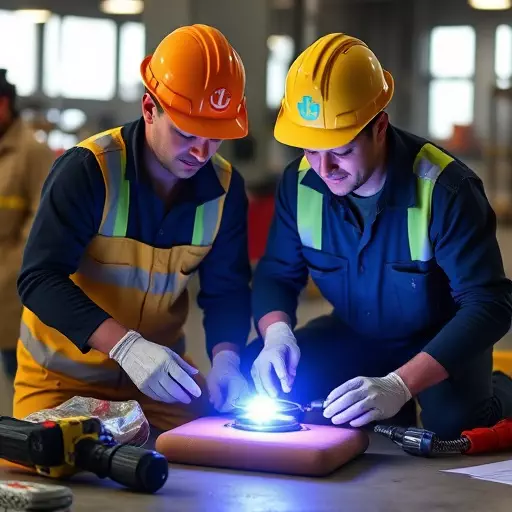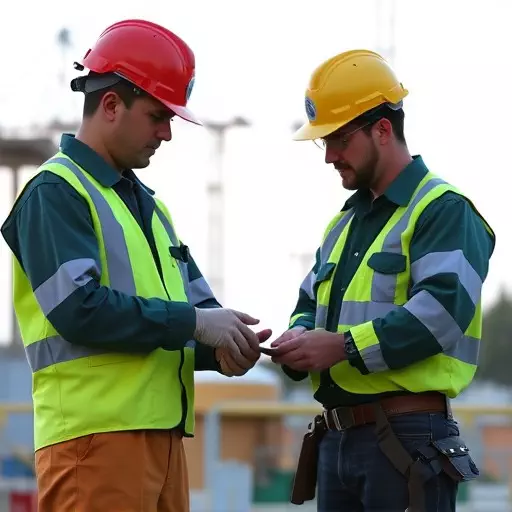In the high-risk construction industry, CPR training and well-equipped first aid kits are vital. OSHA mandates that all construction workers be certified in basic first aid and CPR to handle emergencies, aiming to increase survival rates during cardiac arrest events. This includes addressing common construction site injuries like cuts, burns, and heat illnesses. Adhering to OSHA guidelines, with a focus on CPR training, ensures worker safety and compliance, empowering employees to save lives until professional medical help arrives.
Construction sites present unique challenges, making emergency medical response kits essential. This comprehensive guide explores the critical role of these kits in ensuring worker safety and addressing sudden medical emergencies. We delve into the importance of CPR training for construction professionals, highlighting its lifesaving potential. Additionally, we cover OSHA requirements for CPR certification, provide a checklist of first aid essentials, and offer strategies for proper kit implementation and maintenance.
- Understanding the Importance of Emergency Medical Response Kits in Construction Sites
- CPR Training for Construction Workers: A Lifesaving Skill
- First Aid Basics Every Construction Worker Should Know
- OSHA Requirements for CPR Certification: What You Need to Comply
- Essential Items to Include in Your Construction Site's First Aid Kit
- Implementation and Maintenance: Ensuring Your Kit is Always Ready
Understanding the Importance of Emergency Medical Response Kits in Construction Sites
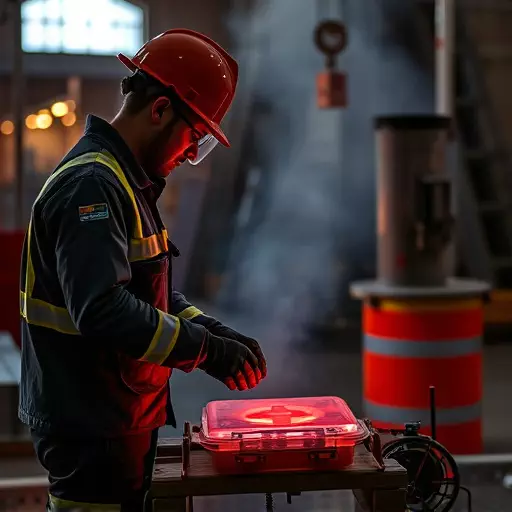
In the dynamic and potentially hazardous environment of construction sites, having well-equipped emergency medical response kits is paramount. These kits serve as lifelines, offering immediate care in critical situations where every minute counts. Construction workers, often facing risks like falls, machinery accidents, or exposure to toxic substances, require specialized training and resources to handle emergencies effectively.
OSHA (Occupational Safety and Health Administration) emphasizes the importance of CPR training for construction workers, ensuring they are prepared to respond to cardiac arrest events. Beyond CPR, first aid basics such as treating wounds, managing bleeding, and recognizing medical emergencies are vital skills. Adhering to OSHA requirements for CPR certification not only ensures compliance but also saves lives by empowering construction workers to act swiftly in emergency situations.
CPR Training for Construction Workers: A Lifesaving Skill
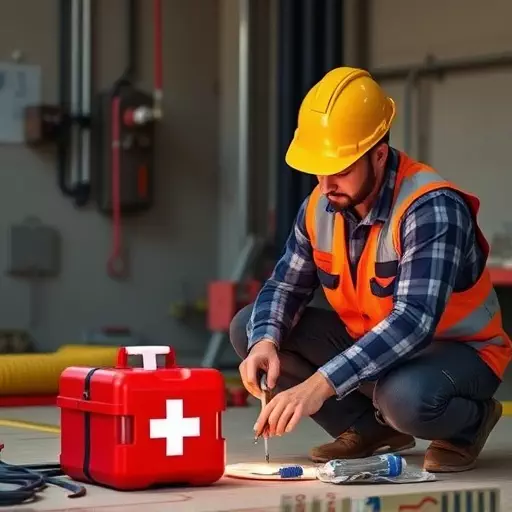
CPR training for construction workers is not just a valuable skill; it’s a lifesaving one. Construction sites are inherently hazardous environments, with risks ranging from heavy machinery to falls and electrical hazards. According to OSHA requirements for CPR certification, all workers should be trained in basic first aid, including cardiopulmonary resuscitation (CPR). This training equips them to handle emergencies before professional medical help arrives. The ability to perform CPR can significantly increase the survival rate of a colleague in cardiac arrest.
Beyond meeting OSHA standards, incorporating CPR training into construction safety programs fosters a culture of care and preparedness. Construction workers equipped with these life-saving skills contribute to a safer work environment for everyone. By understanding the first aid basics for construction workers, individuals can take immediate action in critical situations, ensuring their colleagues receive timely and effective medical intervention until professional help arrives.
First Aid Basics Every Construction Worker Should Know
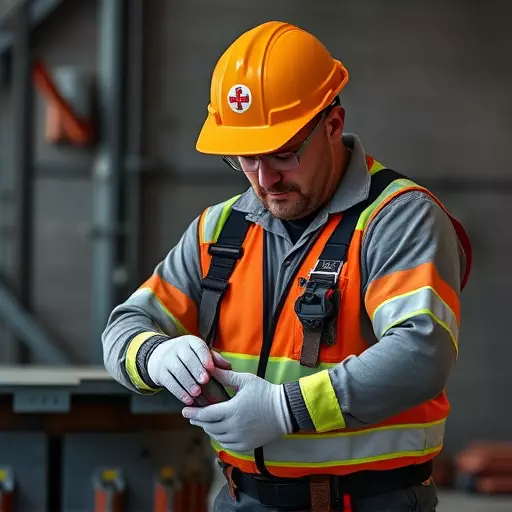
Every construction worker should be familiar with fundamental first aid practices, as they often encounter situations requiring quick and effective action. Basic life-saving skills like cardiopulmonary resuscitation (CPR) are essential tools in an emergency. OSHA (Occupational Safety and Health Administration) mandates that construction sites have trained personnel ready to respond to medical emergencies, including CPR certification for all workers.
Training should cover not just CPR but also recognizing and managing common injuries on construction sites. This includes understanding how to handle cuts, lacerations, burns, fractures, and even heat-related illnesses. Knowing the basic first aid steps for these scenarios can significantly improve outcomes until professional medical help arrives.
OSHA Requirements for CPR Certification: What You Need to Comply

In the dynamic and often hazardous environment of construction sites, ensuring that all workers are equipped with essential first aid knowledge and skills is paramount. The Occupational Safety and Health Administration (OSHA) sets strict guidelines for workplace safety, including requirements for CPR certification among construction personnel. To comply with OSHA standards, employers must provide comprehensive training programs that cover the fundamentals of first aid, with a strong emphasis on cardiopulmonary resuscitation (CPR).
CPR training for construction workers is not just an additional course; it’s a critical component of workplace safety. The first aid basics learned during CPR certification equip workers to handle emergency situations effectively until professional medical help arrives. OSHA requirements for CPR certification ensure that these essential skills are not only taught but also regularly updated, reflecting the latest in lifesaving techniques and best practices.
Essential Items to Include in Your Construction Site's First Aid Kit

A well-stocked first aid kit is an indispensable tool on any construction site, serving as a crucial resource during emergencies. Given the unique risks and challenges inherent in construction work, ensuring that kits are tailored to address these specific needs is essential. Construction workers should be trained in basic first aid and CPR, as this knowledge can prove invaluable in life-or-death situations.
When assembling a kit for your site, include essential items like bandages, sterile gauze pads, and medical tape for treating wounds; eye wash solutions to handle potential chemical splashes or debris; and various sizes of triangular bandages that can be used as slings or to restrict bleeding. Additionally, consider adding an automatic external defibrillator (AED) to your kit, given the high risk of cardiac emergencies. Remember, adhering to OSHA requirements for CPR certification and regular refreshers is vital to maintaining a safe working environment.
Implementation and Maintenance: Ensuring Your Kit is Always Ready

Implementing and maintaining an emergency medical response kit is crucial for any construction site, as it directly impacts the well-being of workers. Construction workers often face unique risks, from falls to heavy equipment accidents, making on-site first aid training and resources indispensable. A well-equipped kit should include essential items like bandages, antiseptics, and a defibrillator (AED), alongside basic first aid manuals tailored for construction hazards.
Regular kit checks and updates are vital to ensure its effectiveness. This includes verifying the expiration dates of medications and supplies, replacing used or damaged items, and updating instructions based on new OSHA guidelines or first aid best practices. Additionally, providing clear instructions on kit usage and promoting CPR training for construction workers can empower employees to respond swiftly during emergencies, potentially saving lives until professional medical help arrives. Adhering to OSHA requirements for CPR certification ensures that all necessary protocols are in place, fostering a safer working environment.
